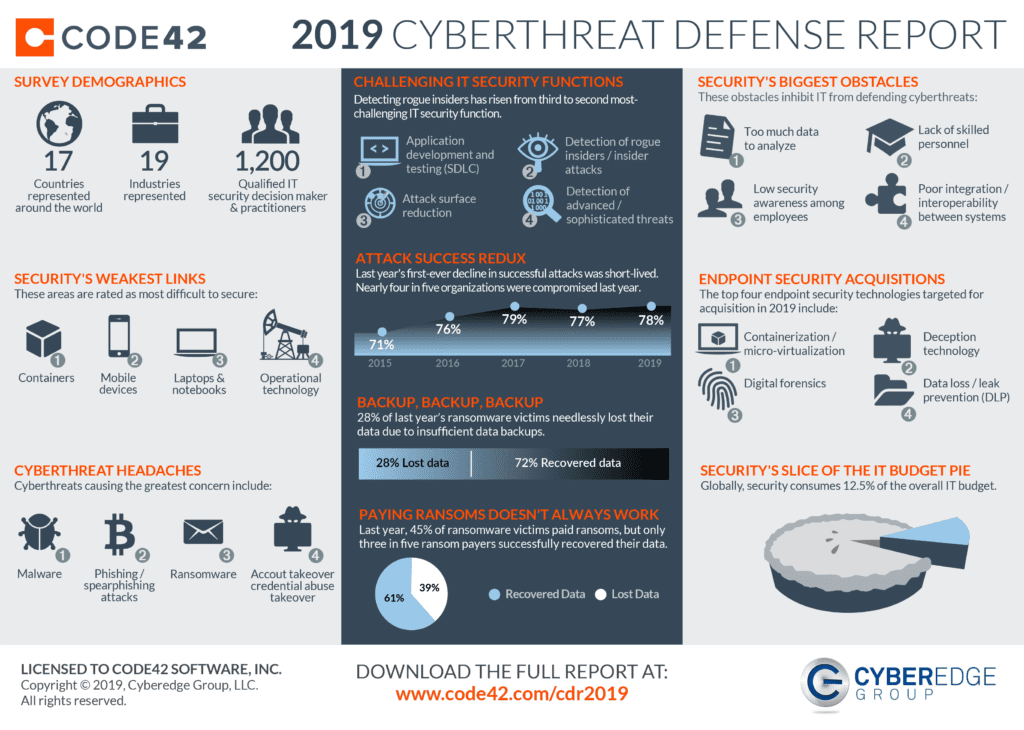This week, I joined Steve Piper, CEO of CyberEdge Group, to review the findings of the 2019 Cyberthreat Defense Report. The Cyberthreat Defense Report is designed to complement Verizon’s annual Data Breach Investigations Report and provides a penetrating look at how IT security professionals perceive cyberthreats and plan to defend against them. This study surveyed 1,200 IT security decision makers and practitioners from 17 countries, six continents and 19 industries.
Among the key findings this year, there are three that are sending a clear signal for the future of information security.
1. Too much security data. This might sound like a negative, but I view it as a good problem to have. After all, if you have all the pertinent data to help you with a security investigation, why wouldn’t you use it? Unfortunately, while the data may exist, the proper tools to decipher and analyze that data doesn’t. This is precisely why 47 percent of respondents acknowledged their organization’s intent to acquire advanced security analytics solutions that incorporate machine learning (ML) technology within the next 12 months.
My take: Having the data is one thing, being able to make quick and visual sense of it is quite another. Quick decision making is paramount and in security, time is emerging as a key factor to mitigating risk.
2. Thirteen percent of overall IT budget is consumed by security. This is up from five percent just two decades ago and will only continue to grow. There also is a critical shortage of qualified IT security personnel, so I expect continued focus on smart investments in technologies.
My take: Security is rightfully taking center stage from a budget perspective. The challenges around too much security data to analyze, lack of skilled security practitioners and the realization that a cyberattack is imminent are only going to keep trending.
3. Insider threats continue to plague security teams. Detecting insider threats remains an enormous challenge for virtually every IT security organization. Although application development and testing remains atop the list of IT security functions perceived as most challenging, detecting rogue insiders and their insider attacks has risen from third place in 2018 to second place in 2019.
My take: Detecting insider threats comes down to how effective a company is in defining, collecting, correlating, analyzing and reporting on insider indicators of compromise. It’s time to take a proactive approach to protecting data.
Other key takeaways:
- Hottest security technology for 2019. Advanced security analytics tops 2019’s most wanted list for not just the security management and operations category, but across all technologies in this year’s report.
- Machine learning (ML) garners confidence. More than 90 percent of IT security organizations have invested in ML and/or artificial intelligence (AI) technologies to combat advanced threats. More than 80 percent are already seeing a difference.
- Attack success redux. The percentage of organizations affected by a successful cyberattack ticked up slightly this year to 78 percent, despite last year’s first-ever decline.
- Caving in to ransomware. Organizations affected by successful ransomware attacks increased slightly to 56 percent. More concerning, the percentage of organizations that elected to pay ransoms rose considerably, from 39 percent to 45 percent, potentially fueling even more ransomware attacks in 2019.
- Container security woes. For the second year, application containers edge mobile devices as IT security’s weakest link.
- Web application firewalls rule the roost. For the second year, the web application firewall (WAF) claims the top spot as the most widely deployed app/data security technology.
- Worsening skills shortage. IT security skills shortages continued to rise, with 84 percent of organizations experiencing this problem compared to 81 percent a year ago.
- Security’s slice of the IT budget pie. On average, IT security consumes 12.5 percent of the overall IT budget. The average security budget is going up by 4.9 percent in 2019.
It’s clear that security teams must ensure their organization’s defenses keep pace with changes both to IT infrastructure and the threats acting against it. The good news, at least for 84 percent of survey respondents, is that their IT security budgets are expected to increase in 2019.

Watch the on-demand webinar or get the full 2019 CyberEdge Cyberthreat Defense Report.
2019 CyberEdge Cyberthreat Defense Report
